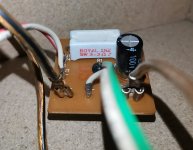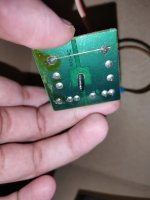My 2 way speakers crossover
Woofer directly connected to amp
Tweeter is through 2.2uf capasitor then one resistor
I am right?
Attaching pic of crossover if I say something wrong let me know
And why is resistor both legs connected together?
Woofer directly connected to amp
Tweeter is through 2.2uf capasitor then one resistor
I am right?
Attaching pic of crossover if I say something wrong let me know
And why is resistor both legs connected together?
Attachments
I imagine that the previous owner modified the crossover shorting the resistor. This way the tweeter sounds louder, how much depends on its impedance. Hint: the solder on the resistor appear different.
Ralf
Ralf
As per my knowledge there was no modification done to this speakers
Is it possible it is manufactured that way ?
Woofer 6ohms
Tweeter 7ohms(measured correctly 3 times with different multimeters)
Overall ohms is 6
Is it possible it is manufactured that way ?
Woofer 6ohms
Tweeter 7ohms(measured correctly 3 times with different multimeters)
Overall ohms is 6
A manufacturer that installs a resistor and then short it rendering it useless... it's a waste of money and time. It's hard to imagine, but who knows. Maybe the crossover was done for another more louder tweeter and was in stock, and the manufacturer used it adding the short. From the photo it is evident that the jumper is added later.
Ralf
PS: what you measure is not impedance but the voice coil resistance, and should be measured with driver disconnected from a crossover. The values you obtained, if measure correctly are consistent with 8 Ohm nominal drivers.
Ralf
PS: what you measure is not impedance but the voice coil resistance, and should be measured with driver disconnected from a crossover. The values you obtained, if measure correctly are consistent with 8 Ohm nominal drivers.
What if i remove the jumper between two legs of resistor?
Or if it there for some specific purpose like frequency changing or something
Or if it there for some specific purpose like frequency changing or something
The resistor decreases tweeter output in its whole working frequency range by some amount. Voltage signal to the tweeter with the jumper removed will be subtracted by 7/3.3 or 2.12 times i.e. about halved. So treble will have less volume. Other than that nothing else should happen as far as I can tell.
@Kamranbits
Looks like your question was already answered.
In other words, the circuit was possibly designed without jumper for another tweeter which had higher loudness than the one you have. One day they decided to use the same circuit for your tweeter but found the loudness to be lower than it should be. Short the resistor and boom! Tweeter singing loud! Although the resistor remains useless, it did cost them money right? Well, these small losses can be afforded if the speaker is mass produced.
Looks like your question was already answered.
Maybe the crossover was done for another more louder tweeter and was in stock, and the manufacturer used it adding the short. From the photo it is evident that the jumper is added later.
In other words, the circuit was possibly designed without jumper for another tweeter which had higher loudness than the one you have. One day they decided to use the same circuit for your tweeter but found the loudness to be lower than it should be. Short the resistor and boom! Tweeter singing loud! Although the resistor remains useless, it did cost them money right? Well, these small losses can be afforded if the speaker is mass produced.
Shorting the resistor will increase the sound right? If they wanted to lower the sound then they should have used the resistor without jumper
Without shorting it, yes. So it's either:Shorting the resistor will increase the sound right? If they wanted to lower the sound then they should have used the resistor without jumper
- Incompetent
- A generic that was used for production convenience rather than for any modicum of quality (but I assume these are ripped out of a pair of mini-system speakers, which are generally rubbish anyway)
- Modified by somebody post-sale who didn't know what they were doing, or
- Some combination of the above.
Yes they belong to aiwa 2 way speakers 45w
As mentioned above
6ohms woofer
7ohms tweeter
If the resistor is used to lower the voice may be this crossover was for some low specs speake they modified it and installed it in higher model
Shorting that resistor might bypass the resistor it will not have any effect on audio as if there is nothing installed
(I am right or there is some specific reason for making sound smooth or something)
As mentioned above
6ohms woofer
7ohms tweeter
If the resistor is used to lower the voice may be this crossover was for some low specs speake they modified it and installed it in higher model
Shorting that resistor might bypass the resistor it will not have any effect on audio as if there is nothing installed
(I am right or there is some specific reason for making sound smooth or something)
If both terminals of the resistor are connected together it's been shorted out of circuit. I've already given possible reasons for that above: it's either
- Incompetence in manufacturing
- The manufacturer recycling a generic filter with a minor modification (which is also incompetent, just in a different way),
- Been modified by somebody for some unknown reason, or
- Some combination of the above
Something I found online
A single attenuating resistor for a dynamic (non-piezo) tweeter would be in series with the tweeter and not in parallel as shown in your image.
Yes and if the resistor both legs are shorted means it's null just for looks it's there if i remove it too no issue right
leave it as is or remove the jumper?
Remove the jumper. Put it back if your tweeter sounds too dull.
- Home
- Loudspeakers
- Multi-Way
- Crossover design why resistor has jumper on both sides


